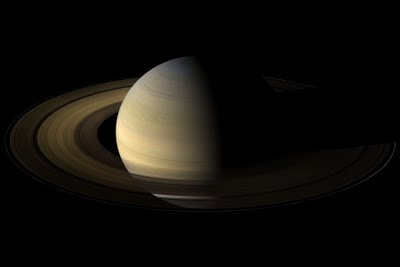 Siempre hay una sección de los anillos de Saturno en la sombra del pLaneta, experimentando una breve noche de entre 6 y 14 horas. Sin embargo, cada 15 años aproximadamente, la noche cae durante cuatro días sobre el sistema completo de anillos.
Siempre hay una sección de los anillos de Saturno en la sombra del pLaneta, experimentando una breve noche de entre 6 y 14 horas. Sin embargo, cada 15 años aproximadamente, la noche cae durante cuatro días sobre el sistema completo de anillos.Esto sucede durante el equinoccio de Saturno, cuando el Sol está directamente sobre el ecuador de saturno. En ese momento los anillos, que también orbitan directamente sobre el ecuador del planeta, quedan de canto con el sol. Durante el equinoccio, la luz del sol se refleja sobre las partículas de los anillos en ángulos muy bajos, resaltando su topografía y dándonos una visión tridimensional de los anillos.
Según el Dr. Michael Flasar del Goddard Space Flight Center de la NASA en Greenbelt (Maryland), "el equinoccio tiene una geometría especial y por lo que respecta a los anillos, es como si el sol se apagara y toda la energía viniera de Saturno"
Durante el último equinoccio saturniano, el 11 de agosto de 2009, los anillos alcanzaron -230ºC, la más fría observada hasta ahora, de acuerdo al Espectrómetro Compuesto Infrarrojo (CIRS) a bordo de la sonda Cassini, en órbita alrededor de Saturno. Flasar es el investigador principal del CIRS, desarrollado en el centro Goddard.
Según Flasar, "el objetivo de las observaciones de los anillos de Saturno, aparte de originar unas fotofrafías asombrosas, es aprender algo sobre las propiedades físicas de las partículas que los forman: sus velocidades de giro, el cómo almacenan o emitin calor (lo que depende de su tamaño y composición) y cuál es su distribución vertical en el plano anular".
Si bien los anillos tienen miles de kilómetros de ancho, su espesor es de apenas 10 metros. Están formados mayoritariamente ppor partículas de hielo acuoso. Los científicos siguen discutiendo sobre el origen y edad de los anillos. Algunos opinan que son los restos de una luna rota o de cometas capturados, mientras que otros piensan que se formaron a la vez que Saturno a partir del disco primitivo de polvo y gas que dio origen a nuestro sistema solar.
El esfuerzo hecho en comprender estos anillos nos ayudará a comprender nuestro origen. Ya que nuestro sistema solar se formó a partir de un disco de polvo, si comprendiéramos la dinámica de un disco como los anillos de saturno, podríamos saber más acerca de como se formaron la Tierra y el resto de los planetas.
As Saturn's rings orbit the planet, a section is typically in the planet's shadow, experiencing a brief night lasting from 6 to 14 hours. However, once approximately every 15 years, night falls over the entire visible ring system for about four days.
This happens during Saturn's equinox, when the sun is directly over Saturn's equator. At this time, the rings, which also orbit directly over the planet's equator, appear edge-on to the sun. During equinox, light from the sun hits the ring particles at very low angles, accenting their topography and giving us a three-dimensional view of the rings.
"The equinox is a very special geometry, where the sun is turned off as far as the rings themselves are concerned, and all energy comes from Saturn," said Dr. Michael Flasar of NASA's Goddard Space Flight Center in Greenbelt, Md.
During Saturn's latest equinox August 11, the rings reached a temperature of 382 degrees below zero Fahrenheit, the coldest yet observed, as seen by the Composite Infrared Spectrometer (CIRS) instrument on board the Cassini spacecraft in orbit around Saturn. CIRS was developed at NASA Goddard, and Flasar is the Principal Investigator for the instrument.
"The whole point of the CIRS observations of Saturn’s rings, other than producing some cool pictures, is to learn something about the physical properties of the ring particles: their spin rates, how sluggish they are in storing and radiating heat (a diagnostic of size and composition), and their vertical distribution in the ring 'plane'," said Flasar.
Although the rings are thousands of miles wide, they are only about 30 feet thick. They are made of particles that are mostly water-ice. Scientists continue to debate the rings' origin and age. Some think they could be remnants of a shattered moon or captured comets, while others think they could have formed along with Saturn from the primordial disk of gas and dust that gave birth to our solar system.
The effort to understand the rings could help us understand our origin. Our solar system formed from a dusty disk, so by understanding the dynamics in a disk like Saturn's rings, we can gain insight into how Earth and the other planets in our solar system were made
Tomado de/Taken from NASA
No hay comentarios:
Publicar un comentario